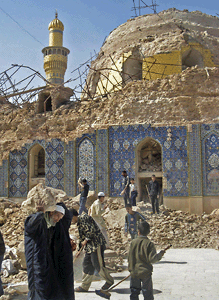Oct. 10-16, 2013, Current Events Lesson Plan
Current Event:
Some 500,000 people died in Iraq as a result of war-related causes that occurred between the U.S.-led invasion in 2003 and the war’s official end in July 2011, according to a new study. The half-million figure included deaths from the invasion, the subsequent insurgency, and the horrific wave of sectarian violence unleashed by the war. The administration of U.S. President George W. Bush launched the invasion of Iraq in March 2003 based on claims that Iraqi President Saddam Hussein and his government were a threat to the security of the United States and other countries. President Bush and U.S. Vice President Richard Cheney accused Hussein of illegally developing and possessing weapons of mass destruction. They also argued that links existed between Hussein’s government and terrorist organizations, including al-Qa`ida, the group responsible for the terrorist attacks in the United States on Sept. 11, 2001. Most experts now doubt that there was any working relationship between Iraq and al-Qa`ida. The claims that Hussein had weapons of mass destruction also turned out to be untrue. Since the war’s official end in 2011, sectarian violence is on the rise in Iraq. According to United Nations statistics, nearly 5,000 civilians have died in sectarian attacks–primarily Sunni militants on Shī`ite civilians–between January and September of this year. More than 3,000 people died in 2012.

The bombing of the al-Askari shrine on Feb. 22, 2006, led to massive violence between Sunni and Shī`ite Muslims and made it more difficult for U.S.-led forces to provide security for Iraqis. The shrine, in Samarra, is one of the holiest sites to Shī`ite Muslims. (© Dia Hamid, AFP/Getty Images)
Objective:
The Iraq War began when U.S.-led coalition forces launched an attack on Iraq in March 2003. The U.S.-led forces controlled most of Iraq by mid-April, after the fall of the Iraqi government of Saddam Hussein. Hussein would later be captured by U.S. troops, convicted by a special Iraqi court of massacring over 140 Shī`ites, and executed by hanging by Iraqi authorities. On May 1, 2003, U.S. President George W. Bush declared that major combat operations had ended. Afterward, U.S., Iraqi, and allied forces from many countries tried to maintain security, restore stability, and rebuild the country. However, Iraqi and foreign militants carried out many attacks against these military and security forces, as well as against civilian targets. United States combat operations in Iraq formally ended on Aug. 31, 2010. Some U.S. troops remained in Iraq until late 2011 to fight terrorism and perform other duties. Over the course of the war, nearly 5,000 coalition soldiers, mainly Americans, were killed. The Behind the Headlines news story and related World Book articles explore the Iraq War.
Words to know:
- Al-Qa`ida
- Baghdad
- Chemical-biological-radiological warfare (CBR)
- George W. Bush
- Iraq
- Iraq War
- Persian Gulf War of 1991
- Richard Cheney
- Saddam Hussein
- September 11 terrorist attacks
- Terrorism
Discussion Topics:
1. Iraq is a Middle Eastern country. Ask your students to name other Middle Eastern countries. (Students might say Egypt, Iran, Israel, Jordan, Saudi Arabia, Syria.)
2. Ask your students what they know about Iraq. (Students might say that Baghdad is Iraq’s capital and largest city; Iraqis are predominately Muslim; Iraq’s economy depends on oil; the world’s first known civilization and other early cultures developed along the Tigris and Euphrates rivers in what is now Iraq.)
3. Ask your students to debate the question, “When is war justified?”
4. Ask your students to use World Book’s Timelines feature to create a timeline of the Iraq War. (Students may wish to use the “Important dates in the Iraq War” table in World Book’s Iraq War article for help.)


